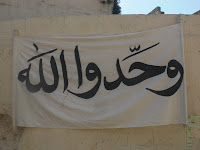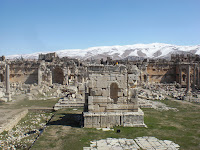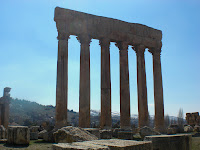 Lebanon's second largest city, Tripoli offers an entirely different
set of sights, smells and impressions to its larger, more cosmopolitan counterpart to the south. The seething, winding alleyways and souqs provide
an authentically oriental atmosphere. Predominantly Sunni Muslim, the
majority of the women wear headscarves. Flags of the Syrian opposition,
currently at war with Assad's government, are on show in many places
around town, along with posters proclaiming 'Syria, Tripoli stands with
you'. Local people generally did not speak English. Many greeted us enthusiastically, others stared at the girls in our group, or at Mads' light blonde hair.
Lebanon's second largest city, Tripoli offers an entirely different
set of sights, smells and impressions to its larger, more cosmopolitan counterpart to the south. The seething, winding alleyways and souqs provide
an authentically oriental atmosphere. Predominantly Sunni Muslim, the
majority of the women wear headscarves. Flags of the Syrian opposition,
currently at war with Assad's government, are on show in many places
around town, along with posters proclaiming 'Syria, Tripoli stands with
you'. Local people generally did not speak English. Many greeted us enthusiastically, others stared at the girls in our group, or at Mads' light blonde hair. We
visited the Crusader Castle at the top of a hill, giving great views
down towards the coast and stretching back to the mountains in the
opposite direction. We also went inside two mosques. Near one, we were
followed by an increasingly large group of children who shouted the only
two expressions they knew in English: "How are you?... Fuck you!". Not
knowing whether to laugh or cry, we continued to the Taylan Mosque,
where it was prayer time. Mads and I went through the gate and across a
wide patio to the 700-year-old building and asked the mu'azzin whether
we could visit. He told us we would be welcome once prayers were done.
We then asked if he had any of the shawls which are often available for
female visitors to borrow. "You have women?" was his slightly amusing
way of checking that he had understood our request.
We
visited the Crusader Castle at the top of a hill, giving great views
down towards the coast and stretching back to the mountains in the
opposite direction. We also went inside two mosques. Near one, we were
followed by an increasingly large group of children who shouted the only
two expressions they knew in English: "How are you?... Fuck you!". Not
knowing whether to laugh or cry, we continued to the Taylan Mosque,
where it was prayer time. Mads and I went through the gate and across a
wide patio to the 700-year-old building and asked the mu'azzin whether
we could visit. He told us we would be welcome once prayers were done.
We then asked if he had any of the shawls which are often available for
female visitors to borrow. "You have women?" was his slightly amusing
way of checking that he had understood our request.
 When
we returned with the rest of the group after prayer time he showed us
around. With a large physical presence, long beard and disarming smile,
he was a memorable character and incredibly welcoming. He told us about
the age of the mosque, its inscriptions and the narrow, winding
staircase to the top of the minaret, where his grandfather would once go
to deliver the call to prayer. These days it's done by microphone and a
PA system. The mu'azzin was also very keen to emphasise similarities
between Islam and Christianity (having assumed we were Christians),
often pointing out the things the two religions have in common, such as
belief in Jesus Christ (in Islam he is one of a number of God's
prophets, subordinate to the prophet Mohammed who received the
definitive final message from God). The mu'azzin was a builder of
bridges and an ambassador for his mosque and religion.
When
we returned with the rest of the group after prayer time he showed us
around. With a large physical presence, long beard and disarming smile,
he was a memorable character and incredibly welcoming. He told us about
the age of the mosque, its inscriptions and the narrow, winding
staircase to the top of the minaret, where his grandfather would once go
to deliver the call to prayer. These days it's done by microphone and a
PA system. The mu'azzin was also very keen to emphasise similarities
between Islam and Christianity (having assumed we were Christians),
often pointing out the things the two religions have in common, such as
belief in Jesus Christ (in Islam he is one of a number of God's
prophets, subordinate to the prophet Mohammed who received the
definitive final message from God). The mu'azzin was a builder of
bridges and an ambassador for his mosque and religion. The return journey to Beirut took place in a ruined minibus
imported from the former West Germany, driven by a pair of clowns who
stopped constantly to buy cans of energy drink (which we later
discovered contains vodka), weaved erratically in and out of the hard
shoulder, hassled the girls sitting on the front passenger row and
turned up the radio when we attempted to talk amongst ourselves. They
also spent more time looking at the radio and their mobile phone than
the road. Their behaviour only improved when other Lebanese people got
on the bus. Luckily, the heavy traffic meant we were travelling too
slowly for the situation to get risky. They then tried to charge us four
times the going rate for the journey. We refused and in fact they
didn't deserve even the standard fare we gave them. I should say that
I've taken other buses on the same route and have otherwise always
encountered professional and safe drivers (according to local norms).
The return journey to Beirut took place in a ruined minibus
imported from the former West Germany, driven by a pair of clowns who
stopped constantly to buy cans of energy drink (which we later
discovered contains vodka), weaved erratically in and out of the hard
shoulder, hassled the girls sitting on the front passenger row and
turned up the radio when we attempted to talk amongst ourselves. They
also spent more time looking at the radio and their mobile phone than
the road. Their behaviour only improved when other Lebanese people got
on the bus. Luckily, the heavy traffic meant we were travelling too
slowly for the situation to get risky. They then tried to charge us four
times the going rate for the journey. We refused and in fact they
didn't deserve even the standard fare we gave them. I should say that
I've taken other buses on the same route and have otherwise always
encountered professional and safe drivers (according to local norms).Tripoli is a timely reminder that Lebanon is an Arab country with a sizeable Muslim population, something easy to lose sight of in the hard-partying, wealthy districts of Beirut. The different populations seem to keep themselves to themselves - for example taxi drivers from West Beirut often need to be given directions in order to find places in East Beirut, and vice versa (like a tragic version of London's "don't go south of the water" cabbies). Although as I have mentioned before, there does not seem to be any open animosity between people. Perhaps this is a way of keeping the precarious peace intact.
Another aspect of Lebanese society less than obvious to many visitors is the poverty present in outer districts of Beirut, the Palestinian camps, amongst migrant workers and even amongst Bedouin people - this according to an NGO researcher I recently had the opportunity to speak to about the subject. I have still not really experienced much poverty myself, apart from noticing that all refuse collectors are South Asians, and that maids and other household staff are generally African. As the researcher I spoke to said, even the road to Beirut airport has been diverted so that it avoids passing close to the poverty-stricken districts of the city.













